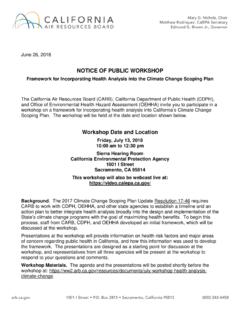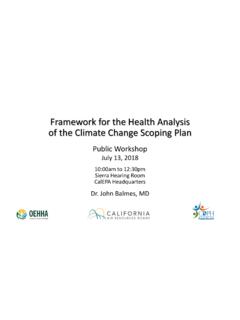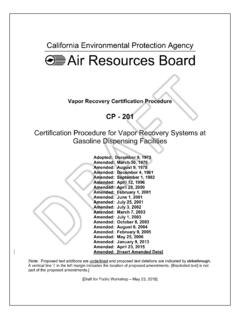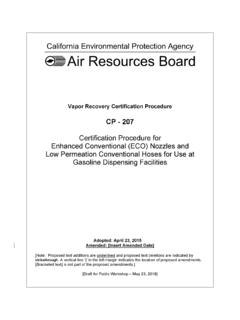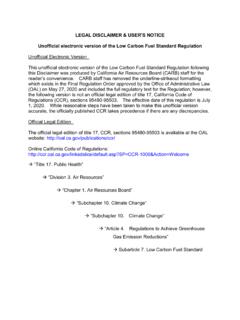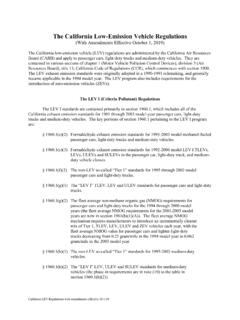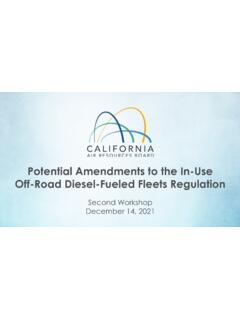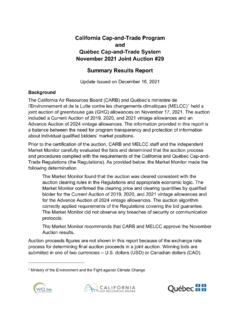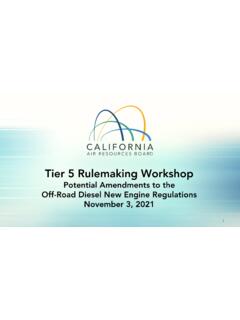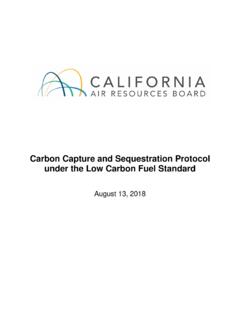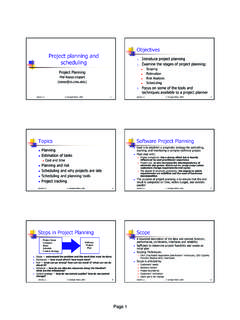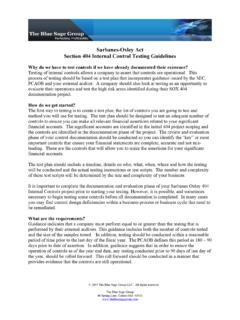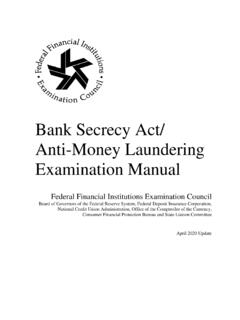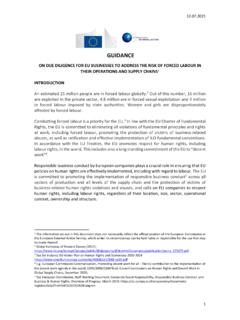Transcription of DRAFT Report: Achieving Carbon Neutrality in California
1 Achieving Carbon Neutrality in California PATHWAYS Scenarios Developed for the California Air Resources Board DRAFT : August 2020 PATHWAYS Scenarios Developed for the California Air Resources Board 2020 Copyright. All Rights Reserved. Energy and Environmental Economics, Inc. 44 Montgomery Street, Suite 1500 San Francisco, CA 94104 Project Team: Amber Mahone Zachary Subin Gabe Mantegna Rawley Loken Clea Kolster Niki Lintmeijer Achieving Carbon Neutrality in California DRAFT : August 2020 Table of Contents Executive Summary .. 1 Study Purpose and Approach .. 1 Scenarios .. 2 Scenario Results .. 3 Key Findings .. 8 Least-regrets Options .. 8 Challenges, Risks, and Opportunities .. 9 Uncertainties .. 11 Introduction .. 12 What Climate Science Tells Us About the Urgency of Reducing Greenhouse 12 Motivating Questions and Report Organization.
2 13 California s Carbon Neutral Executive Order and Supporting Policies .. 14 Strategies and Findings Across Carbon Neutral Studies .. 15 European Deep Decarbonization Studies .. 16 2 Modeling Approach, Scenario Design and Greenhouse Gas Reduction Strategies .. 19 About the California PATHWAYS Model .. 19 Greenhouse Gas Emissions Accounting and Boundary Conditions .. 20 Carbon Neutral Scenarios .. 21 GHG Reduction Strategies by Sector .. 26 Low- Carbon Liquid and Gaseous Fuels .. 27 Buildings .. 31 Transportation .. 37 Industry and Agriculture .. 44 Electricity .. 52 High Global Warming Potential Gases and Non-Combustion Greenhouse Gas Emissions .. 57 Carbon Dioxide Removal .. 61 3 Discussion of Key Findings .. 65 Scenario Comparison Across Key Metrics.
3 65 Fuel Combustion: Implications for Air Quality and Health Considerations .. 66 Climate Change Mitigation Risk .. 68 Technology Adoption & implementation Risk .. 68 Estimated 2045 Cost Per Ton of Advanced Mitigation Measures .. 72 4 Conclusions and Next Steps .. 76 Summary of Key Conclusions .. 76 Areas for Further Study and Next Steps .. 78 5 References .. 80 6 Appendix .. 88 Description of Cost Ranges of Advanced Mitigation Measures and 88 Carbon Neutrality Goals in Other Jurisdictions .. 90 Acronyms BECCS Bioenergy with Carbon Capture and Sequestration BEV Battery Electric Vehicle CARB California Air Resources Board CCS Carbon Capture and Storage CDR Carbon Dioxide Removal CNG Compressed Natural Gas CO2 Carbon Dioxide CO2e Carbon Dioxide equivalent DAC Direct Air Capture DACCS Direct Air Capture with Storage EE Energy Efficiency GHG Greenhouse Gas GWh Gigawatt hours GWP Global Warming Potential HFC Hydrofluorocarbon HFCV Hydrogen Fuel Cell Vehicle LCFS Low Carbon Fuel Standard MMT Million metric tons NET Negative Emission Technology RD&D Research, Development and Demonstration VMT Vehicle Miles Travelled ZCE Zero Carbon Energy (scenario)
4 Page | 1 | Executive Summary 2020 Energy and Environmental Economics, Inc. Executive Summary Study Purpose and Approach This study evaluates scenarios that achieve Carbon Neutrality in California by 2045. Specifically, the scenarios evaluated here achieve at least an 80% reduction in greenhouse gases from 1990 levels by 2045. Carbon Neutrality means that all greenhouse gas (GHG) emissions emitted into the atmosphere are balanced in equal measure by GHGs that are removed from the atmosphere, either through Carbon sinks or Carbon capture and storage. This work specifically focuses on pathways to reduce Carbon dioxide emissions from energy use in buildings, transportation, and industry, as well as from other non-combustion and high global warming potential GHGs, including methane, nitrous oxide, and refrigerant gases: hydrofluorocarbons (HFCs), perfluorocarbons, sulfur hexafluoride, and nitrogen trifluoride.
5 Natural and working lands will also play a pivotal role in addressing climate change. Natural and working lands sequester Carbon dioxide in forests, soils, and oceans; these Carbon sinks can be enhanced through land and ecosystem management practices. Likewise, natural and working lands can also represent a source of greenhouse gas emissions, due to land use changes such as deforestation and wildfires. This study does not evaluate the role of natural and working lands as either a net source or a net sink for greenhouse gas emissions in California . The California Air Resources Board and other agencies are continuing to research and collect data on the state s historic and current Carbon flux from natural and working lands to help inform a more complete view of the path to Carbon Neutrality in the state.
6 Future updates of California s Climate Change scoping plan will include emissions targets for this sector, considering the role of natural and working lands as an emissions source and as a potential sink alongside the transportation, energy, and industrial sectors. DRAFT : Achieving Carbon Neutrality in California Page | 2 | The purpose of this study is to help to inform considerations for the California Air Resources Board initial development of the 2022 scoping plan update. The DRAFT report may be revised based on comments received on the initial scenario results. These scenarios build on Energy and Environmental Economics (E3 s) prior research into deep decarbonization strategies to achieve a 40% reduction in GHG emissions by 2030, and an 80% reduction by 2050 ( 80x50 ), relative to 1990 levels, as well as a literature review of deep decarbonization studies, including emerging research from European studies.
7 Key study questions include: What are the available energy and non-combustion GHG reduction strategies to help achieve Carbon Neutrality by 2045? How should California consider the tradeoffs between Achieving additional energy-sector greenhouse gas reductions versus relying on Carbon dioxide removal? How do different mitigation strategies compare on the basis of fuel combustion (implying air quality and health impacts), climate change mitigation risk, and technology adoption and implementation risk? What are least regrets strategies that are likely to be indispensable in working towards Carbon Neutrality ? Scenarios The authors evaluate three scenarios that achieve net zero emissions by 2045, excluding natural and working lands, using the California PATHWAYS model, each with ambitious reductions in fossil fuel-related GHGs and direct emissions of non-energy, non-combustion greenhouse gases.
8 All scenarios include high levels of energy efficiency across all sectors, high levels of renewable electricity generation, high levels of electrification in the transportation and buildings sector, and deep reductions in non-energy, non-combustion greenhouse gas emissions like methane and HFCs. As a result, all scenarios achieve at least Page | 3 | Executive Summary 2020 Energy and Environmental Economics, Inc. an 80% reduction in gross GHG emissions (under AB 32) by 2045 ( 80x45 ), representing new and ambitious actions and technology deployments to reduce emissions in California . The scenarios differ in their level of adoption of advanced mitigation measures that result in over 80% reduction in GHG emissions by 2045 and their degree of their reliance on Carbon dioxide removal (CDR) to achieve Carbon Neutrality by The High CDR scenario achieves an 80% reduction in gross greenhouse gas emissions by 2045, and of the scenarios evaluated, relies most heavily on Carbon dioxide removal strategies to achieve Carbon Neutrality by 2045.
9 The Zero Carbon Energy scenario achieves zero-fossil fuel emissions by 2045, with some remaining gross emissions from non-combustion and high GWP gases by 2045. CDR strategies are minimized in this scenario. The Balanced scenario represents a middle point between the prior two scenarios in terms of energy-related GHG reductions. This scenario includes less CDR than the High CDR scenario, and more CDR than the Zero Carbon Energy scenario. Scenario Results The scenarios are ranked based on their performance across key metrics, including health-related air quality impacts (approximated based on combustion of fuels), climate risk, and technology adoption and implementation risk. Carbon abatement cost ranges for the advanced mitigation measures and Carbon 1 Carbon dioxide removal is a term that encompasses many forms of GHG removal from the atmosphere, whether through natural and working lands Carbon sequestration (not evaluated here), or through negative emissions technologies that actively pull Carbon dioxide out of the atmosphere, such as direct air capture or biomass energy with Carbon capture and sequestration.
10 DRAFT : Achieving Carbon Neutrality in California Page | 4 | dioxide removal required for each scenario to go beyond 80x50 and achieve Carbon Neutrality are also evaluated but the relative cost impact of each scenario is deemed uncertain. The High CDR scenario achieves approximately an 80% reduction in direct GHG emissions by 2045, with approximately 80 million metric tons (MMT) of CO2e removed from the atmosphere using a combination of CDR strategies. This scenario represents the highest risk scenario, from a climate mitigation perspective, because it has the highest remaining direct GHG emissions, and relies on relatively untested CDR strategies which are not widely commercialized. The scenario also has the highest remaining quantity of fuel combustion, which means the air quality impacts, though far improved relative to today, will likely be highest among the three Carbon neutral scenarios evaluated.
